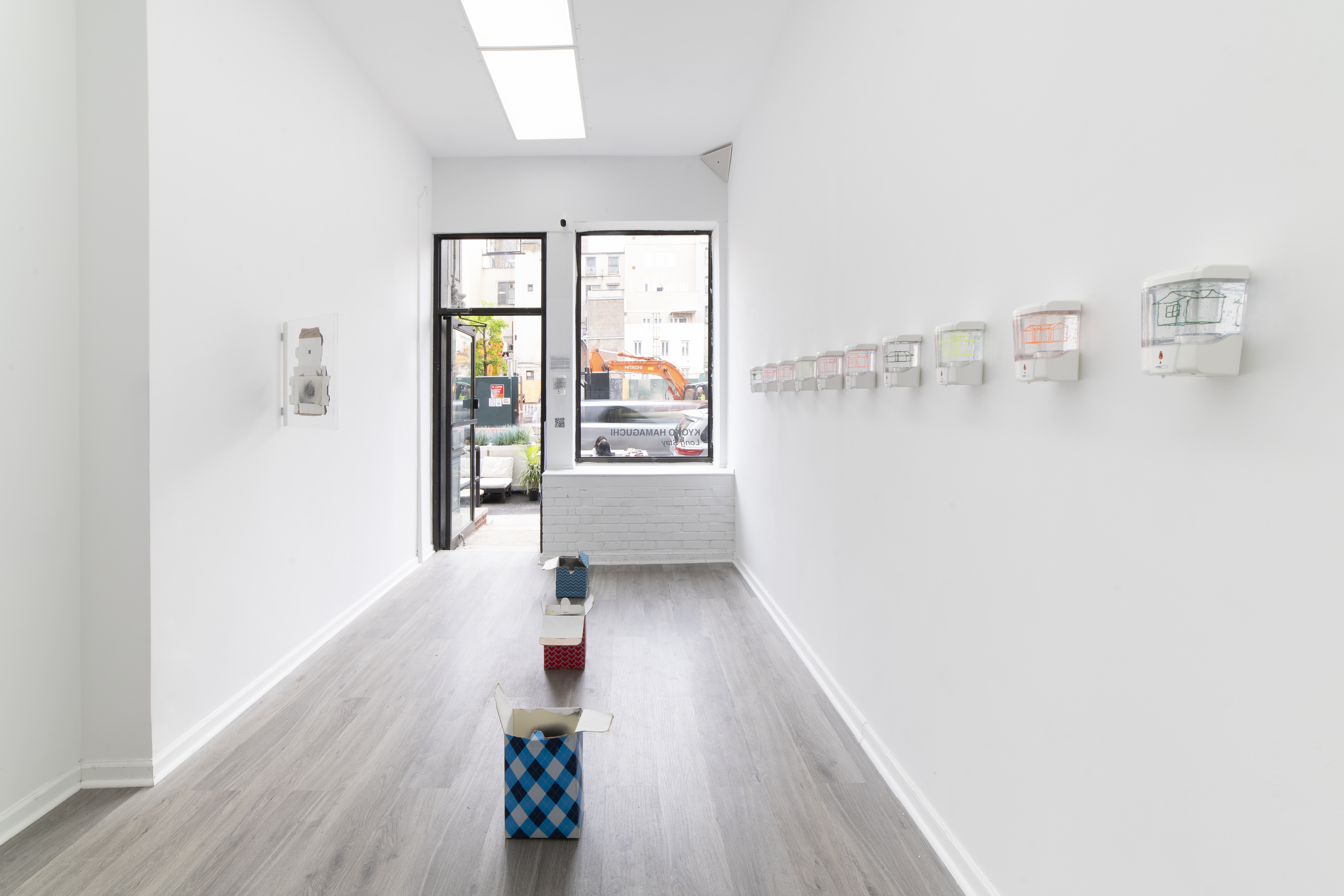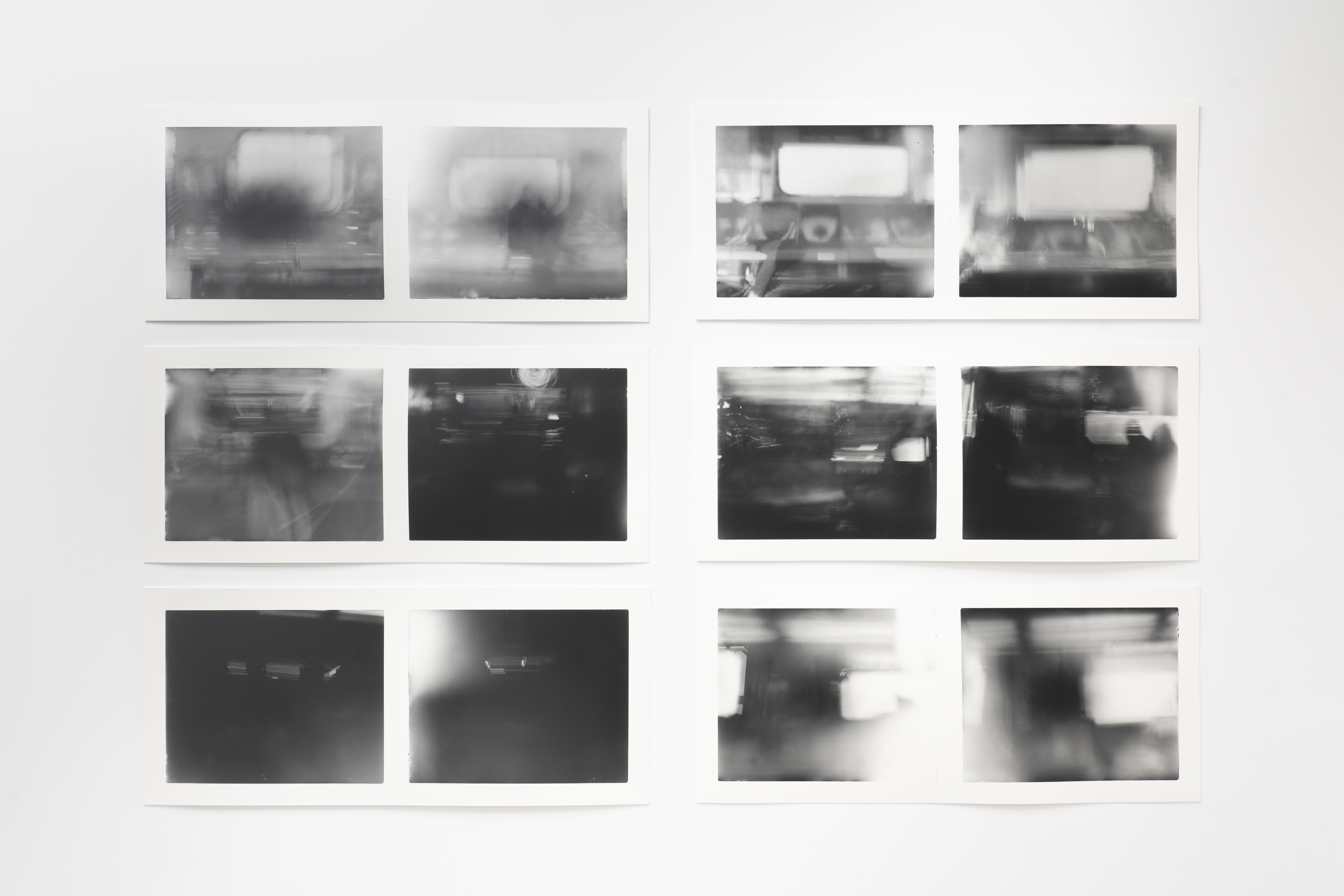Whitehot Magazine
October 2025
"The Best Art In The World"
"The Best Art In The World"
October 2025
Kyoko Hamaguchi at ATM Gallery
 Kyoko Hamaguchi, Long Stay, installation view. Courtesy of the artist and ATM Gallery. Photo by Jesse Meredith.
Kyoko Hamaguchi, Long Stay, installation view. Courtesy of the artist and ATM Gallery. Photo by Jesse Meredith.
Kyoko Hamaguchi: Long Stay
April 29 through May 30, 2021
By JONATHAN GOODMAN, May 2021
Japanese-born, New York City-based artist Kyoko Hamaguchi is new to New York, having moved here only three years ago. She is also young. But her art is already highly developed. Primarily a painter, the artist works with pinhole cameras that record journeys--in subway routes and trips recorded in the cardboard mail carriers used by postal companies that she has turned into cameras. In this show, she also has a project using dispensers of sanitizer, into which she has placed small, delicate outlines of houses made by thread, which slowly disintegrate as the sanitizer is used. It is not a generalization to say that, in Hamaguchi’s work, the Japanese traditional ability with craft is merged with the Western orientation toward conceptual advance; the qualities allow her to cleverly approach ideas about time. Time is an ancient idea in art and thinking, but it is extremely hard to illustrate or record. Yet this artist’s unusual ability in finding ways to visualize the passage of the hours makes her, even though she is only in her early thirties, an artist of unusual depth.
 Kyoko Hamaguchi, Sanctuary 6a, 2020. Courtesy of the artist and ATM Gallery. Photo by Jesse Meredith.
Kyoko Hamaguchi, Sanctuary 6a, 2020. Courtesy of the artist and ATM Gallery. Photo by Jesse Meredith.
In the front room of the gallery space, we see on the wall, some five feet high, a row of ten evenly spaced plastic dispensers of hand sanitizer. Inside the small plastic containers are the outlines of single houses, each made with differently colored thread. As people use the sanitizer, which they are allowed to do, the level of the gel drops, and when that happens the thread houses start to break apart as they hit the bottom of the container--one house was already half broken. The cleverness of the piece is performance-based: the more the sanitizer is dispensed, the faster the house falls apart. Sanitizer is ubiquitous now, in the age of the virus quarantine, while the visual metaphor of a home breaking has also long been used as well as a literary device. So the combination of the contemporaneity of the sterilizing gel, along with the ongoing trope of a broken home, makes the piece both timely and ongoing--and maybe a bit melancholy.
In the middle of the front room, on the floor, there is a line of pinhole cameras that Hamaguchi constructed within the cardboard boxes used by USPS. Hamaguchi sent them on to various destinations, and the cameras recorded within the images associated with the length of the trip. The results were small, mostly abstract-looking pictures with some parts that could be recognized. The title of the show, “Long Stay,” might refer to the artist’s ongoing residence in New York, or it might describe the long period the pinhole camera recorded on the trips the cameras took. Whatever the reason for the name of the show, the images, seen in a moment, also record the duration of the journey.
 Kyoko Hamaguchi, Time Medium, 2017. Courtesy of the artist and ATM Gallery. Photo by Jesse Meredith.
Kyoko Hamaguchi, Time Medium, 2017. Courtesy of the artist and ATM Gallery. Photo by Jesse Meredith.
In the back gallery, there is a suite of black-and-white photographs, each of them a diptych describing the same point of view. Taken on excursions Hamaguchi made on all 23 subway lines in New York, from the first stop to the last, the images are dark and not easy to read--but also evocative and beautifully mysterious, seemingly both a recognizable transcription of a journey--the doors and the windows of the subways are visible--and a somewhat abstract image. These photographs are unusually elegant, given their rough, improvisatory origins, and moving in the sense that the imagery reduces a period of time to a single image--it is as if time might be stopped. In another way, they are records of performances: Hamaguchi’s “long stay” riding the numerous subway lines from start to finish. Interestingly, the short rides, such as the one on the shuttle train from Times Square to Grand Central, are very dark as the amount of time used in recording the image is very brief, only one minute. So the pinhole letting in light does not have the length of time to make the image brighter, as happens in some of the other pictures.
In the back of the front room, there is a large canvas cart filled with failed cameras--this is genuine honesty on Hamaguchi’s part. At the top of this first space, in the upper-left corner of the wall as you enter the gallery, a pinhole camera is recording entrances and exits and movement inside--perhaps this is a nod to the lack of privacy we currently endure. Hamaguchi’s work might be pushed to the side if the show were about ideas alone, but the nature of her art, more visual than conceptual, more than simply redeems it--it turns the exhibition into a delicate meditation on the endless, seamless nature of time. It is quite remarkable to see how complex the ideas are in the artist’s work, when Hamaguchi is using such simple means. “Long Stay” is a show of unusual intelligence and originality. WM

Jonathan Goodman
Jonathan Goodman is a writer in New York who has written for Artcritical, Artery and the Brooklyn Rail among other publications.
view all articles from this author









